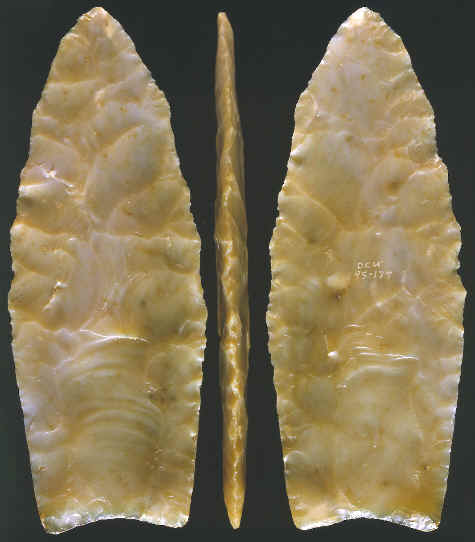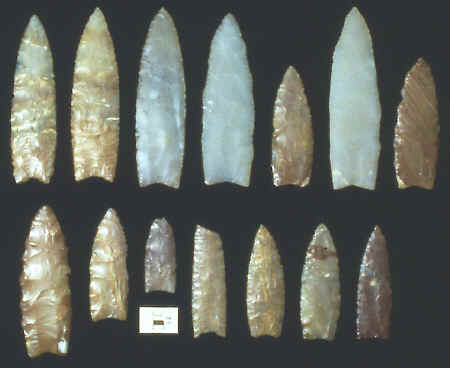|

CLICK ON
PICTURE FOR LARGE IMAGE
WENATCHEE
STYLE CLOVIS POINT
MADE BY D.C. WALDORF
DONNIE
McKINNIS COLLECTION
This picture shows three views of what D.C. Waldorf believes
to be his best made Clovis point so far to date. The style is
copied from the large Clovis points that were found
in the Wenatchee Clovis site cache in Washington state. |
|
|
Fluting
for this Clovis point was done with direct percussion flaking with a
moose antler billet. D.C. said he accomplished this by "jamming the
blunt tip of the preform into the side of my upper thigh and hit it with
a large slow moving antler billet". This Clovis point measures 6
1/2 inches (16.5 cm) long.
|
|

PHOTO CREDIT AND COPYRIGHT DR. R.M. GRAMLY
CLICK ON
PICTURE FOR LARGE IMAGE
CLOVIS POINTS
EAST WENATCHEE CLOVIS SITE
DOUGLAS COUNTY, WASHINGTON
OWNED BY THE STATE
OF WASHINGTON
These 14 clovis points were found during the excavation of the East
Wenatchee Clovis site. Most of them were probably used mainly as
knives but at least one or more of the smaller points may have been
used on spears. |
|
|
Large Clovis points like the one replicated by D.C. and the ones found
in the East Wenatchee Clovis site cache would have been used as knives
rather than projectile points. One theory for the rough saw-tooth-like
edges on some of the points was for cutting meat, possibly frozen meat.
These prominent bumps at the flake scar junctures along the edges are
called "lugs" by D.C. He says that he doubts that they were
platform preparations for further flake removals. He also notes that
although the blade edges are irregular, the cutting edge is actually
extremely straight, so much so that it had to be done on purpose.
|
|
"REFERENCES"
2000,
"Clovis Points Then and Now", Chips, Vol. 12, #14, by D.C.
Waldorf, pp. 12, 16.
Personal communications with D.C. Waldorf.
|
|
HOME
ORDERING |